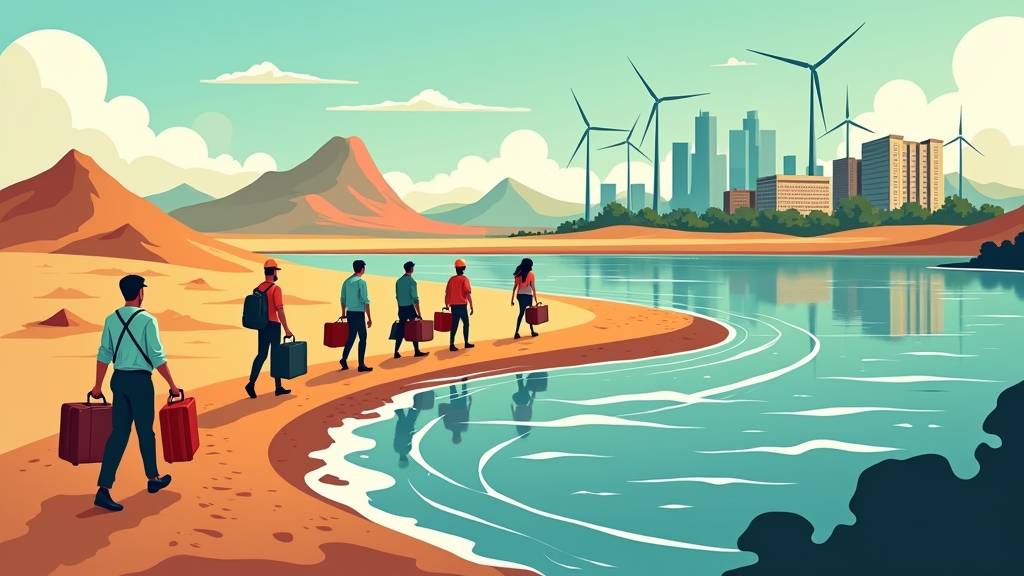Advertising
The Phenomenon of "Climate Transition Jobs" and Their Impact on the Global Market
Imagine waking up one day and discovering that your city no longer exists as you knew it. Forest fires, catastrophic floods or prolonged droughts have made the place uninhabitable. What would you do? For millions of professionals around the world, this is not a distant hypothesis, but an urgent reality. Forced migration due to environmental disasters is creating a new flow in the labor market: the "climate transition work".
This phenomenon isn't just about people leaving their homes - it's about how entire economies are being reshaped, how skills are being reassessed and how countries are coping with the sudden arrival of displaced workers. Which professions are most affected? How are governments and companies reacting? And what does this mean for the future of employment?
In this article, we'll explore how climate change is redefining the global employment landscape, from farmers becoming urban factory workers to engineers specializing in post-disaster reconstruction. We'll also discuss the challenges-and opportunities-that arise when the environment dictates the rules of the game.
What is "Climate Transition Work"?
When we talk about climate transition workWe are not just talking about green or sustainable jobs. The concept is broader: these are occupations that arise or change due to the forced displacement of professionals by extreme environmental events. These workers often have to adapt to new realities, whether by moving to a different region, acquiring different skills or even entering completely new sectors.
A clear example comes from agriculture. In the northeast of Brazil, long periods of drought have led small producers to abandon their land and seek opportunities in urban centers. Many end up in informal jobs, such as construction or domestic service. In Australia, devastating forest fires have forced farmers to migrate to cities, where some have reinvented themselves as solar energy technicians - a skill on the rise in the country.
But it's not just manual workers who are being affected. Skilled professionals are also facing challenges. Environmental engineers, for example, are in demand in flood-prone regions, while architects specializing in resilient construction are increasingly in demand. The question that remains is: how to prepare the workforce for this new reality?
Advertising
Governments and international organizations have already begun to act. Professional retraining programs, such as those offered by International Labor Organization (ILO)are helping climate migrants to adapt. However, the scale of the problem demands more comprehensive and urgent solutions.
Climate Migration: Who Are the Most Affected?
If you think the impacts of climate change at work are a distant problem, think again. Data from World Bank indicate that, by 2050, more than 140 million people can be displaced within their own countries due to extreme weather events. But who is on the front line?
Farmers and fishermen are among the most vulnerable. Their professions depend directly on stable environmental conditions, and when these conditions change, there is often no alternative but to leave. In Southeast Asia, for example, the salinization of soils due to rising sea levels has rendered farmland unproductive, forcing entire families to seek new sources of income.
Another group heavily impacted are construction workers in coastal areas. With the increase in hurricanes and tropical storms, many regions are becoming unviable for housing and, consequently, for construction work. In the United States, after Hurricane Katrina, thousands of workers migrated to other states, overloading already saturated labor markets.
But what about high-level professionals? They are also feeling the effects. Cities like Miami, threatened by rising oceans, are already seeing a flight of talent in sectors like technology and finance. Companies are reconsidering the location of their offices, and qualified employees are opting for regions less susceptible to disasters. In the future, will the "best job" be the one least exposed to the weather?
Inequality also plays a crucial role. Low-income workers have fewer resources to adapt, while wealthier professionals can relocate more easily. This creates an even greater divide in the labor market-something that public policies urgently need to address.
The emergence of new professions and skills
While some careers are declining due to climate change, others are emerging - and fast. Have you heard of "climate risk manager" or "urban resilience technician"? These are just two of the many professions that are gaining ground in a world where environmental disasters are becoming increasingly frequent.
Insurance companies, for example, are hiring experts in climate risk modeling to calculate the financial impacts of extreme events. Similarly, city governments are looking for urban planners capable of designing cities that can withstand floods, heatwaves and other phenomena. What do these professions have in common? They all require a combination of technical knowledge and adaptability-skills that will become increasingly valuable.
But it's not just in the formal sector that things are changing. In communities affected by disasters, informal opportunities are emerging. After the earthquake in Haiti in 2010, many survivors found work in reconstruction, learning basic construction skills in the process. In Brazil, after the extreme rains in Petrópolis (2022), local residents were trained to work in early warning systems - a life-saving service.
And what about education? Universities and technical institutes are already adjusting their curricula. Courses on renewable energies, water management and sustainable architecture are on the rise. Online platforms such as CourseraThe other two offer specialized programs in this area. Are we preparing the next generation for a changing world - but at the speed needed?
The Challenges for Companies and Governments
While there are new opportunities, the challenges are enormous. Companies operating in vulnerable regions need to rethink their strategies - and fast. How do you keep a team motivated when the threat of a disaster hangs over their heads? How do you recruit talent in areas that could become inhospitable within a decade?

Some corporations are already adopting climate mobilityThis has allowed employees to transfer to branches in safer locations. Others are investing in training to help employees acquire resilient skills. A Unilever, for example, has sustainability training programs for its employees - a way of preparing them for future changes in the market.
Governments, for their part, face even greater dilemmas. How to integrate climate migrants into the local economy without overloading public services? How to avoid conflicts between local communities and newcomers? In Germany, where recent floods have displaced thousands, the government has created tax incentives for companies that hire those affected. In Bangladesh, one of the countries most threatened by rising seas, planned migration programs are being tested.
But solutions cannot be isolated. International cooperation is essential. Organizations such as UN Climate Change are pushing for global agreements to protect displaced workers. After all, climate change doesn't respect borders - and neither should the responses.
The Role of Technology and Innovation
Technology can be a great ally in this transition. From recruitment platforms specializing in green jobs to disaster prediction tools, innovation is helping to mitigate the impacts on the job market.
Artificial intelligence systems, for example, are already being used to predict which regions are most at risk of becoming uninhabitable - allowing governments and companies to plan relocations in advance. Startups such as ClimaCell (now Tomorrow.io) offer hyperlocal climate analysis, helping farmers make safer decisions.
In addition, remote work - accelerated by the pandemic - can be a way out for professionals in at-risk areas. A programmer who lives in a coastal city threatened by the sea doesn't necessarily have to migrate; he can work for a company in another country. Could the future of climate work lie in digital?
But technology also brings risks. Automation could leave many climate migrants without jobs, especially in sectors such as manufacturing and transportation. Balancing innovation with inclusion will be one of the great challenges of the coming decades.
How can you prepare?
If there is one certainty in this scenario, it is that adaptation will be crucial. But how can you, as a professional, prepare for this new reality?
First, invest in resilient skills. Courses in sustainability, crisis management or green technologies can make a difference. Platforms such as Udemy offer affordable training in this area.
Second, be open to mobility. If your region is at risk, consider opportunities elsewhere - before the move is forced.
Third, follow public policies. Governments are launching programs to support workers affected by the climate. Stay tuned.
Finally, get involved in the discussion. The climate transition at work is an issue that affects everyone - and your voice can help shape fairer solutions.
The Future of Work in a Warming World
The phenomenon of climate transition work is not a distant possibility - it's already happening. And while some see only crisis, others see opportunity.
New professions are emerging. Business models are reinventing themselves. And the way we understand employment will never be the same.
The question that remains is: are we acting fast enough? Or will we be caught by surprise, watching entire economies collapse?
The time to act is now. And each of us - governments, companies and individuals - has a role to play.
The future of work will be shaped by the climate. And only those who adapt will thrive.



